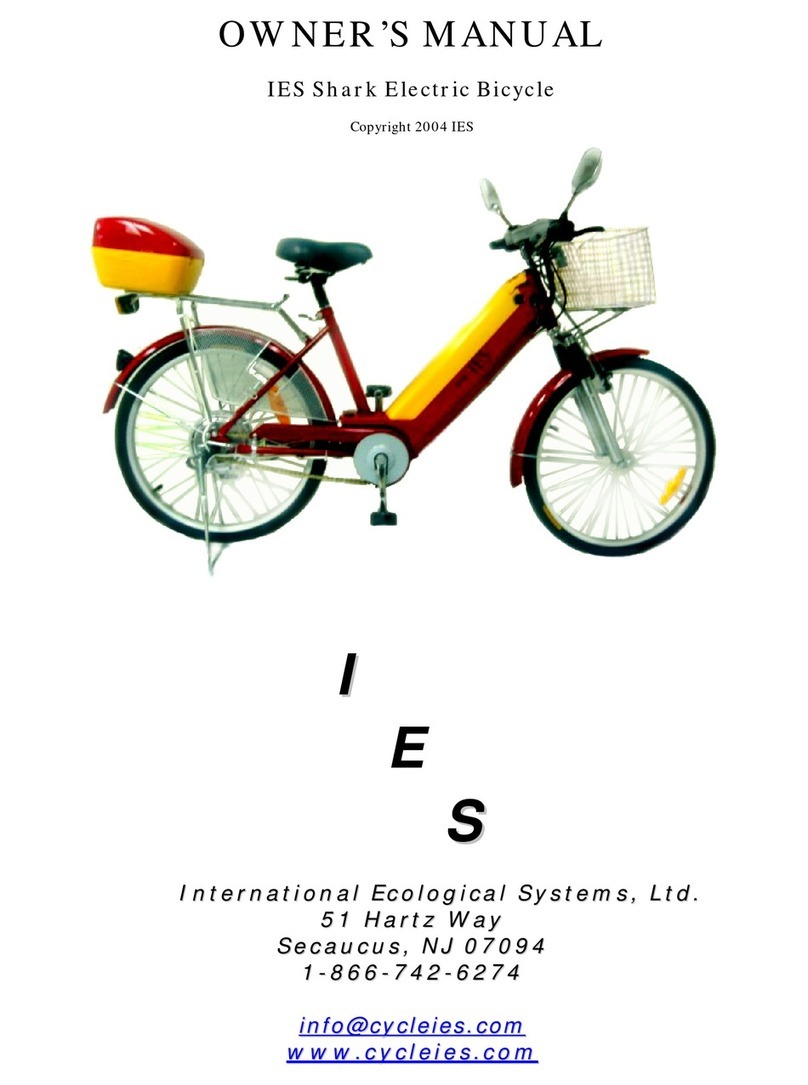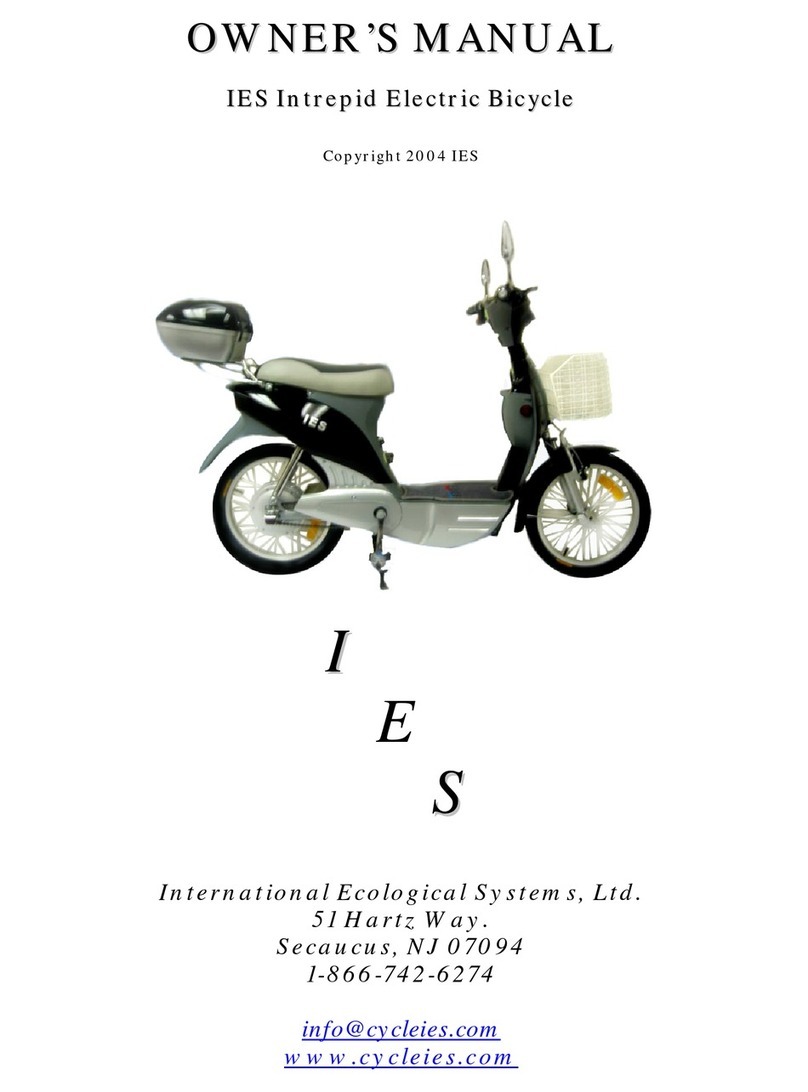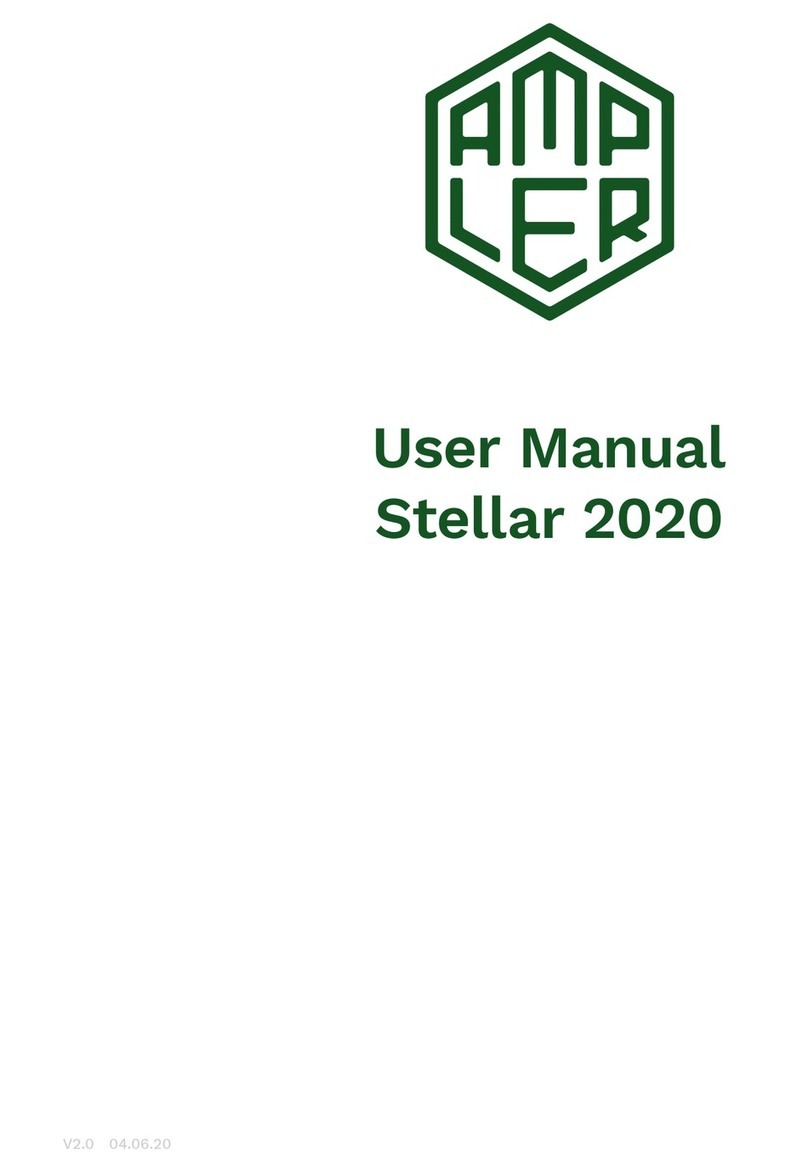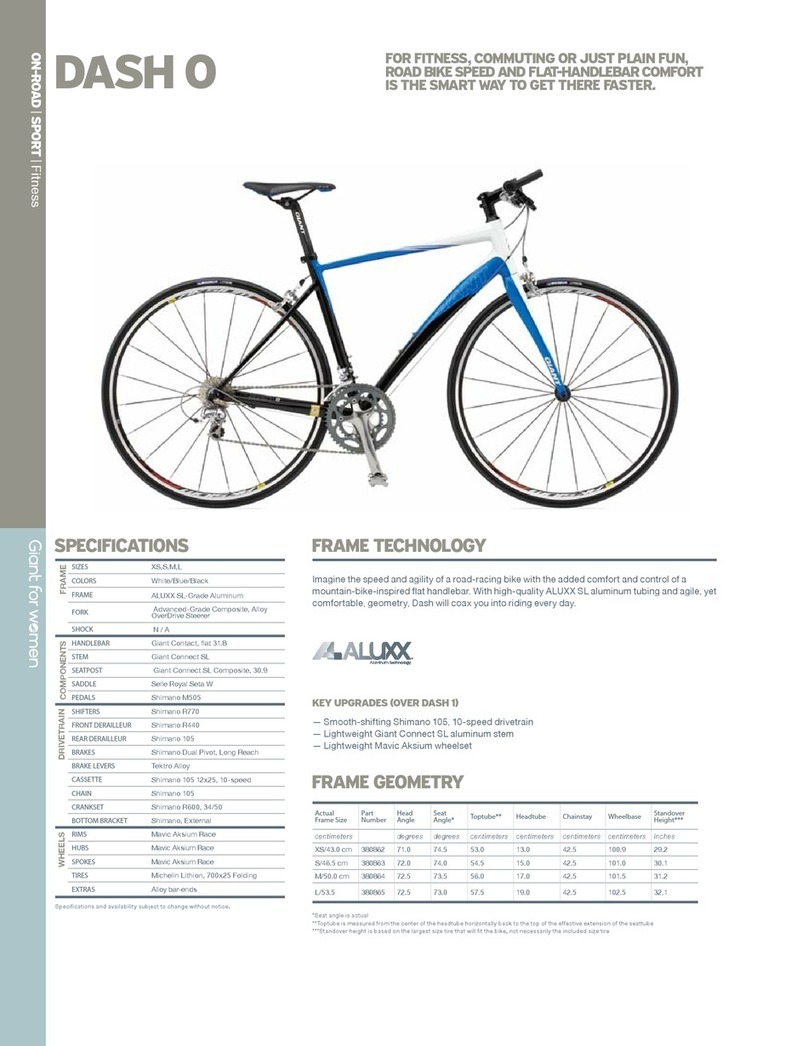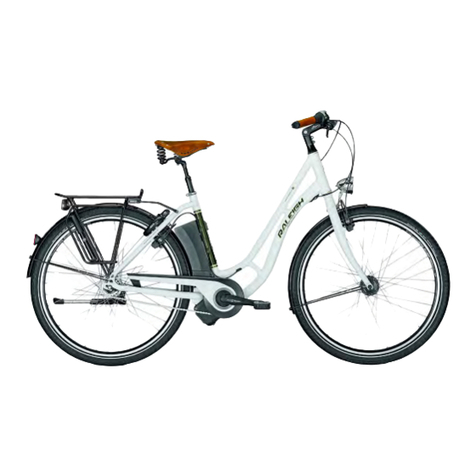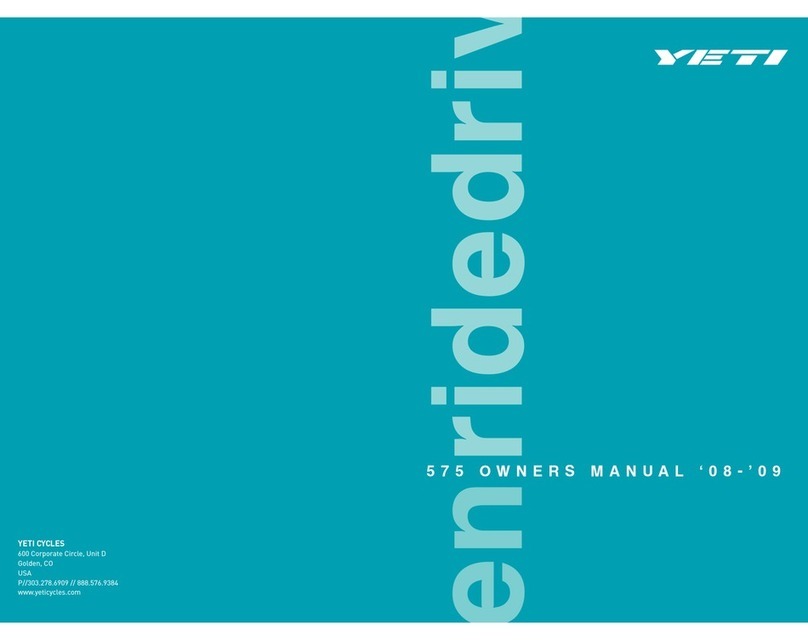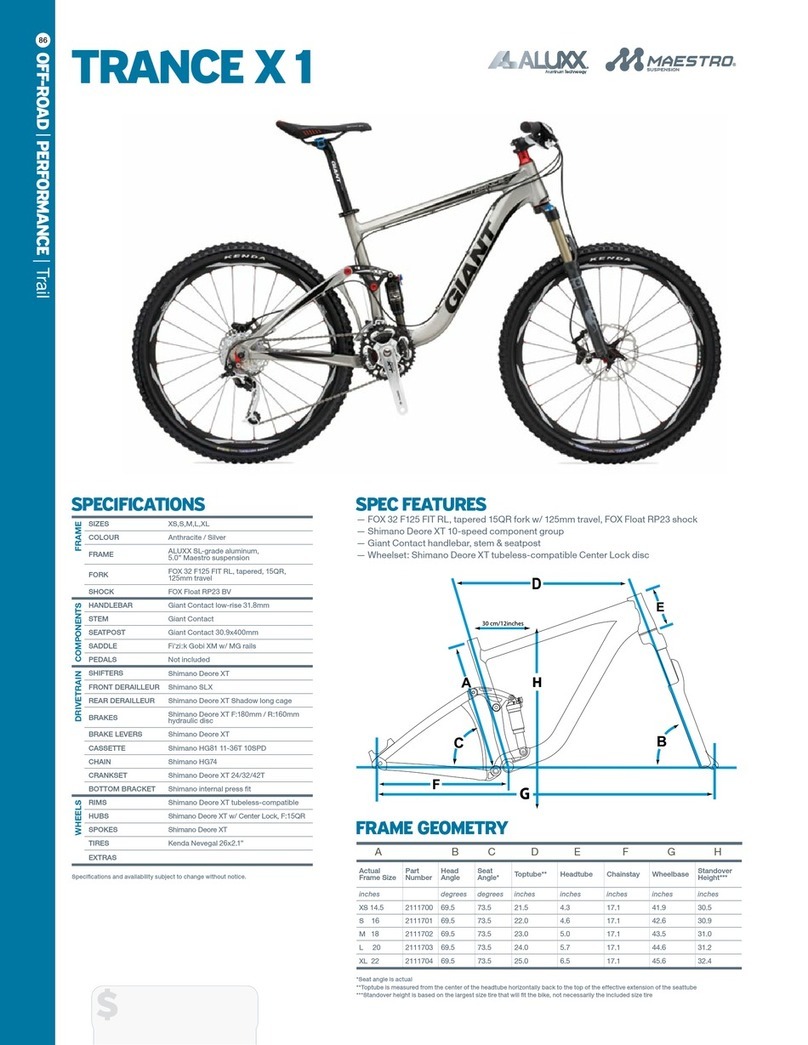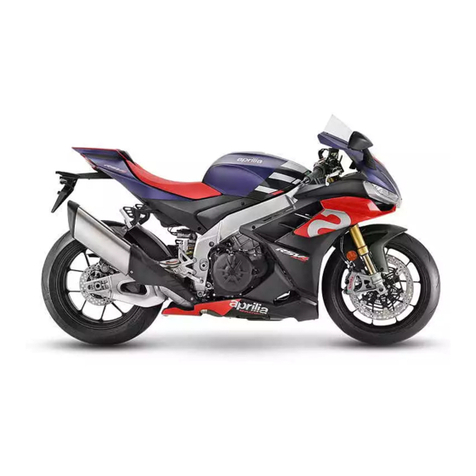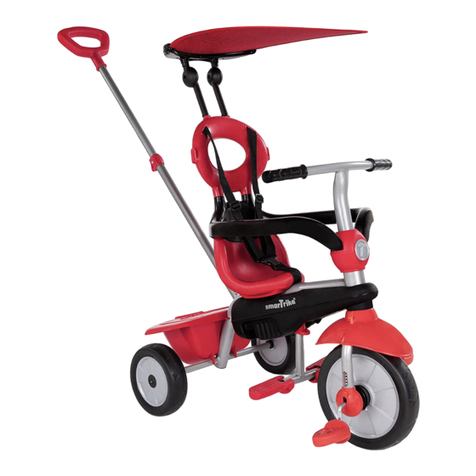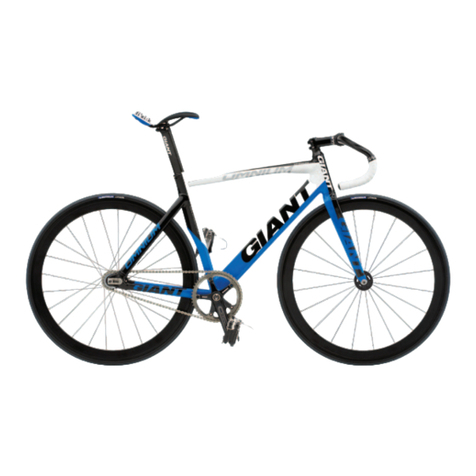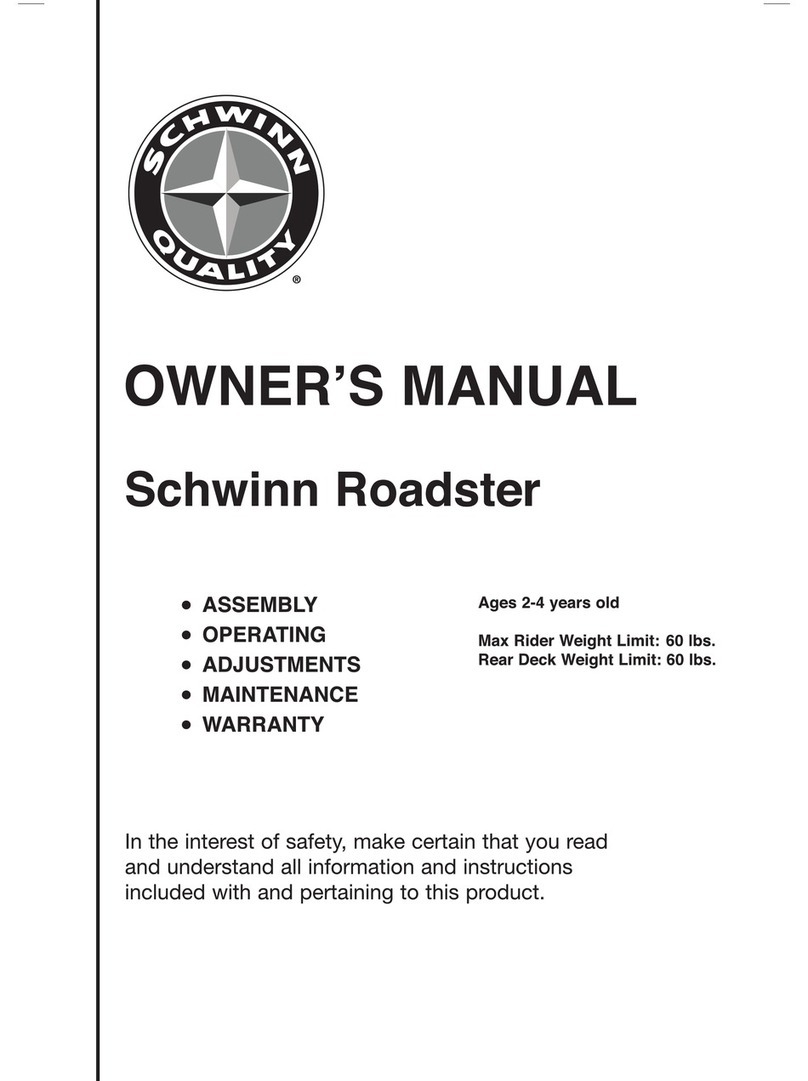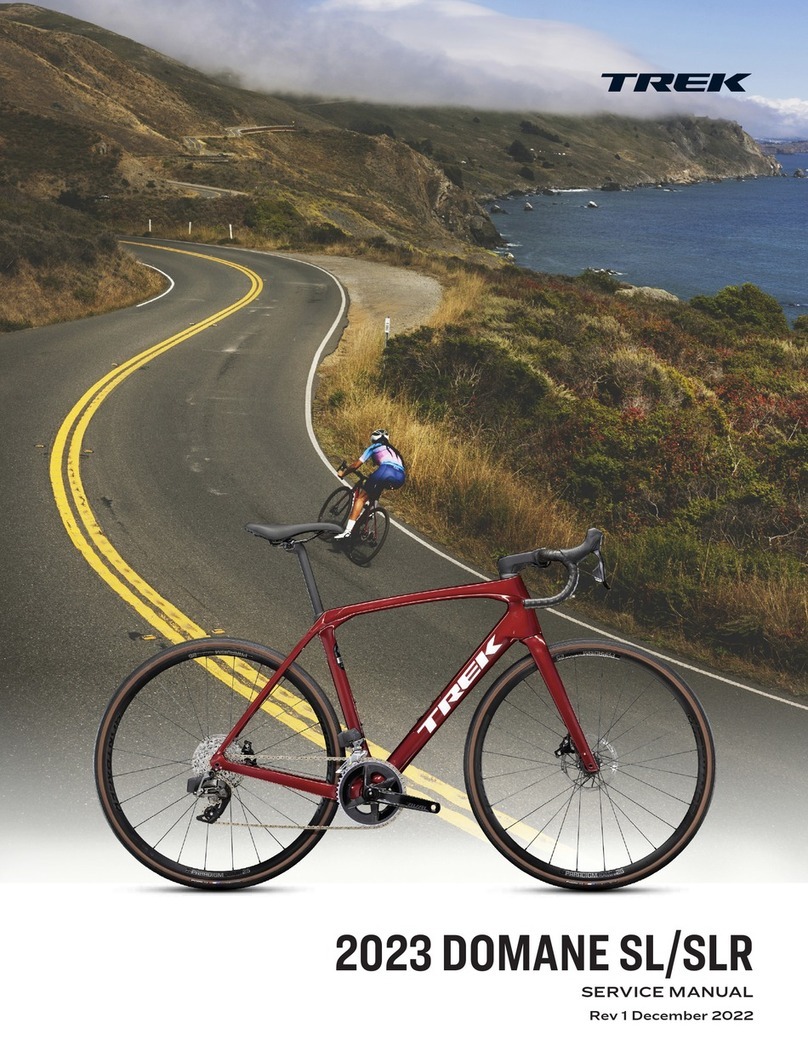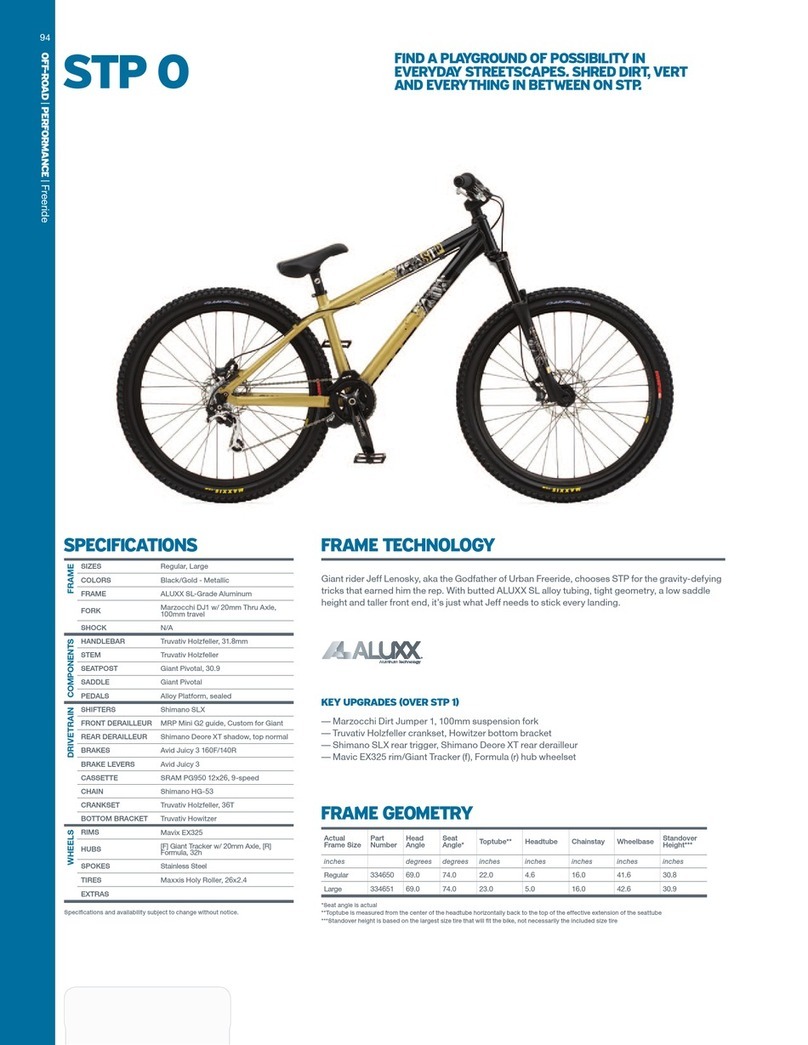IES IES Quicksilver User manual

OWNER’S MANUAL
IES Quicksilver Electric Bicycle
Copyright 2004 IES
I
I
E
E
S
S
I
In
nt
te
er
rn
na
at
ti
io
on
na
al
l
E
Ec
co
ol
lo
og
gi
ic
ca
al
l
S
Sy
ys
st
te
em
m,
,
L
Lt
td
d.
.
5
51
1
H
Ha
ar
rt
tz
z
W
Wa
ay
y
S
Se
ec
ca
au
uc
cu
us
s,
,
N
NJ
J
0
07
70
09
94
4
1
1-
-8
86
66
6-
-7
74
42
2-
-6
62
27
74
4
i
in
nf
fo
o@
@c
cy
yc
cl
le
ei
ie
es
s.
.c
co
om
m
w
ww
ww
w.
.c
cy
yc
cl
le
ei
ie
es
s.
.c
co
om
m

O
OW
WN
NE
ER
R’
’S
S
M
MA
AN
NU
UA
AL
L
–
–
I
IE
ES
S
Q
QU
UI
IC
CK
KS
SI
IL
LV
VE
ER
R
IMPORTANT!
Congratulations on selecting the IES Quicksilver. In order to use and enjoy your
bicycle safely and to get the best performance and durability from this product,
please read this manual before riding.
Warning! Even on the best days, riding or operating any sort of
vehicle is hazardous. Serious injury or death can occur as a result.
This manual contains many cautions and warnings. It is important
that you read and understand the material outlined in this manual.
We want you to be completely satisfied with your Quicksilver. If you have any
questions or concerns, please call the IES team at 1-866-742-6274.
Each bicycle comes with a Vehicle Identification Number (VIN) embossed into
the frame. Please record the VIN along with other pertinent information below in
the event that the bicycle is lost or stolen. It may also be a god idea to register
your VIN number with the local police department.
VIN:
Model:
Color:
Date of
Purchase:
Place of
Purchase:
I
IN
NT
TE
ER
RN
NA
AT
TI
IO
ON
NA
AL
L
E
EC
CO
OL
LO
OG
GI
IC
CA
AL
L
S
SY
YS
ST
TE
EM
M,
,
L
LT
TD
D.
.
1
1-
-8
86
66
6-
-7
74
42
2-
-6
62
27
74
4
P
Pa
ag
ge
e
2
2
o
of
f
1
19
9

O
OW
WN
NE
ER
R’
’S
S
M
MA
AN
NU
UA
AL
L
–
–
I
IE
ES
S
Q
QU
UI
IC
CK
KS
SI
IL
LV
VE
ER
R
QUICKSILVER-BUTTER YELLOW
I
IN
NT
TE
ER
RN
NA
AT
TI
IO
ON
NA
AL
L
E
EC
CO
OL
LO
OG
GI
IC
CA
AL
L
S
SY
YS
ST
TE
EM
M,
,
L
LT
TD
D.
.
1
1-
-8
86
66
6-
-7
74
42
2-
-6
62
27
74
4
P
Pa
ag
ge
e
3
3
o
of
f
1
19
9

O
OW
WN
NE
ER
R’
’S
S
M
MA
AN
NU
UA
AL
L
–
–
I
IE
ES
S
Q
QU
UI
IC
CK
KS
SI
IL
LV
VE
ER
R
Table of Contents Page
•Record of serial number 2
•Photo of Quicksilver 3
•Table of Contents 4
•Cautions and Warnings 5
•Inspection 6
•Illustration of bike 7
•Assembly Instructions 8
•Adjusting the Brakes 9
•Operational Instructions / Electric Bike components 10
•Recharging your Battery 13
•Pre-cautions while recharging your battery 14
•Bicycle Care 15
•Safety Responsibility 16
•Warranty 17
•Troubleshooting 18
•Specifications 19
I
IN
NT
TE
ER
RN
NA
AT
TI
IO
ON
NA
AL
L
E
EC
CO
OL
LO
OG
GI
IC
CA
AL
L
S
SY
YS
ST
TE
EM
M,
,
L
LT
TD
D.
.
1
1-
-8
86
66
6-
-7
74
42
2-
-6
62
27
74
4
P
Pa
ag
ge
e
4
4
o
of
f
1
19
9

O
OW
WN
NE
ER
R’
’S
S
M
MA
AN
NU
UA
AL
L
–
–
I
IE
ES
S
Q
QU
UI
IC
CK
KS
SI
IL
LV
VE
ER
R
CAUTIONS AND WARNINGS
Please read this section! It is very important for your safety and
satisfaction that you read these cautions and warnings. Thanks!
Warning! Always wear your helmet, obey local laws, and
exercise caution when riding.
Warning! If you are not certain that your bike is safe to ride,
take it to an authorized dealer and ask for a safety inspection.
Warning! Keep the power switched off until you are seated on
the bike and ready to ride. Turning the power on, and then
accidentally twisting the hand throttle can result in the bike accelerating or
“jumping” and cause damage or injury.
Warning! Never attempt to disassemble the battery, motor,
controller, or throttle. This can result in injury, fire, or damage to the
bike.
Warning! Only use the charger that was supplied with your bike
to charge the battery. Use of the improper charger can result in fire or
explosion.
Warning! Substituting batteries, changing motors or
controllers will void the warranty and may result in various
types of safety problems including fire, explosion, excessive
sped, or lack of control. All service should be performed by an
authorized dealer. Modifications of any sort will void the warranty.
Warning! Avoid contact with live wires, or the battery
terminals. Although the voltage is low, the amperage is high. Burns and
other injuries can result from contact with any body part.
Warning! Keep the battery and charger out of the reach of
children.
Warning! Read the enclosed instructions for the operations of
your charger. Follow the instructions. Not all chargers work the same
way. Failure to use the charger properly can result fire, shock, explosion,
or injury.
Caution! Fully charge the battery before the first use. Failure to
do this can result in decreased battery performance for the life of the bike.
Fully charge the battery each time you use the bike.
Caution! Do not store your new bike where it will be exposed to
high heat, high humidity, or rain for extended periods. All of
these will decrease the life and appearance of your bike.
Caution! Do not immerse your bike in water especially sea
water. This can damage or destroy the electrical components.
I
IN
NT
TE
ER
RN
NA
AT
TI
IO
ON
NA
AL
L
E
EC
CO
OL
LO
OG
GI
IC
CA
AL
L
S
SY
YS
ST
TE
EM
M,
,
L
LT
TD
D.
.
1
1-
-8
86
66
6-
-7
74
42
2-
-6
62
27
74
4
P
Pa
ag
ge
e
5
5
o
of
f
1
19
9

O
OW
WN
NE
ER
R’
’S
S
M
MA
AN
NU
UA
AL
L
–
–
I
IE
ES
S
Q
QU
UI
IC
CK
KS
SI
IL
LV
VE
ER
R
INSPECTION
The following is a list of all the necessary parts and components of your new
Quicksilver. Please make sure everything is enclosed in the box and in good
working condition.
Bicycle
1 Comfort Saddle
2 Pedals
Power Source (charger)
Took Kit
Battery
Warranty Card
Owner’s Manual
Please check the bike along with the parts and components thoroughly for any
damage that may have been sustained during shipping. Be careful to avoid
scratching the frame when untying or unpacking the bicycle and components.
If you find that something is missing, please call the IES team toll free at: 1-
866-742-6274.
I
IN
NT
TE
ER
RN
NA
AT
TI
IO
ON
NA
AL
L
E
EC
CO
OL
LO
OG
GI
IC
CA
AL
L
S
SY
YS
ST
TE
EM
M,
,
L
LT
TD
D.
.
1
1-
-8
86
66
6-
-7
74
42
2-
-6
62
27
74
4
P
Pa
ag
ge
e
6
6
o
of
f
1
19
9

O
OW
WN
NE
ER
R’
’S
S
M
MA
AN
NU
UA
AL
L
–
–
I
IE
ES
S
Q
QU
UI
IC
CK
KS
SI
IL
LV
VE
ER
R
Figure 1 – Parts of your QuicksilverFigure 1 – Parts of your Quicksilver
2
3
5
6
8
9
10
11
12
17
21
14
15
18
19
20
22
25
26
24
23
13
4
1
7
9
16
QUICKSILVER-BUTTER YELLOW
1 – Brake Lever 10 – Battery Indicator 19 – Saddle
2 – Handlebar 11 – Battery (under seat) 20 – Rear Shocks
3 – Speedometer 12 - Kickstand 21 – Rear Brake
4 – Front Brake 13 - Pedal 22 – Luggage Rack
5 – Stem 14 – Crank Arm 23 – Gear
6 – Mirrors 15 – Power On/Off 24 – Charging Port (under Seat)
7 – Front Fork 16 – Wire Harness 25 – Display
8 – Tire (Front & Rear) 17 - Motor 26 – Rear Locking Carrier
9 – Rim (Front & Rear) 18 – Under Seat Lock
I
IN
NT
TE
ER
RN
NA
AT
TI
IO
ON
NA
AL
L
E
EC
CO
OL
LO
OG
GI
IC
CA
AL
L
S
SY
YS
ST
TE
EM
M,
,
L
LT
TD
D.
.
1
1-
-8
86
66
6-
-7
74
42
2-
-6
62
27
74
4
P
Pa
ag
ge
e
7
7
o
of
f
1
19
9

O
OW
WN
NE
ER
R’
’S
S
M
MA
AN
NU
UA
AL
L
–
–
I
IE
ES
S
Q
QU
UI
IC
CK
KS
SI
IL
LV
VE
ER
R
ASSEMBLY INSTRUCTIONS
Tools Required For Assembly
This bicycle can be assembled with the tools supplied in the bike’s shipping
carton.
For this bike, a set of metric Allen wrenches, an 8” crescent wrench, a
standard screwdriver, slip joint pliers, a Phillips screwdriver, and a tire pump
are needed for assembly.
Assembly Instructions
Please read through and follow all instructions to ensure that your Quicksilver
is properly assembled and ready for use.
Remove the bicycle form the box by lifting cutting the sides of the box away.
Avoid lifting the bike straight up out of the box.
Remove all of the wrappings and ties that protect the bicycle during shipment.
Install the pedals. The pedals are marked R and L for right hand and left
hand pedals. Since the right hand pedal is reverse threaded, you must rotate
the wrench towards the front of the bicycle to tighten the pedals on both sides.
Be wary of accidentally trying to install the pedals on the wrong sides of the
bike. The right hand side of the bike is the side that is on the rider’s right
when they are sitting on the seat.
Local bicycle shops are usually willing to assemble bicycles for a fee and they
will often check a bicycle for safety at no charge.
Fill the tires with air to the recommended pressure and charge the battery
before riding.
Test and adjust the brakes and gears as needed.
If you have any questions, call the IES Service Team at: 1-(866) 726-6856.
I
IN
NT
TE
ER
RN
NA
AT
TI
IO
ON
NA
AL
L
E
EC
CO
OL
LO
OG
GI
IC
CA
AL
L
S
SY
YS
ST
TE
EM
M,
,
L
LT
TD
D.
.
1
1-
-8
86
66
6-
-7
74
42
2-
-6
62
27
74
4
P
Pa
ag
ge
e
8
8
o
of
f
1
19
9

O
OW
WN
NE
ER
R’
’S
S
M
MA
AN
NU
UA
AL
L
–
–
I
IE
ES
S
Q
QU
UI
IC
CK
KS
SI
IL
LV
VE
ER
R
ADJUSTING THE BRAKES
Adjust the brakes by turning the adjusting nuts located at the junction of the
brake cable and brake lever. When you have determined the proper setting,
turn the knurled knob at the shaft of the adjusting bolt all the way down to the
brake lever to lock the brake setting in place.
The right brake lever controls the rear brake. To tighten brakes, turn the
adjusting nut clockwise. To loosen brakes, turn the adjusting nut
counterclockwise.
The left brake lever controls the front brake. To tighten brakes, turn the
adjusting nut counterclockwise. To loosen brakes, turn the adjusting nut
clockwise.
Note: Left and right brake controls are reversed in some countries. Check
your levers and brakes to be sure you know which lever operates which brake.
Brake Testing
Squeeze the brake levers. The brake levers should be easy for you to reach, and
engage the brakes completely when pulled in. You should not be able to pull
the brake lever in until it touches the handlebar or grip. Test the brakes and the
brake lever adjustment; you should be able to comfortably control your brakes.
If the brake is adjusted too loose, the extra play will cause insufficient braking
power. The play is properly adjusted if the brake pads meet the rim fully when
the brake lever is pulled one-third of the way.
I
IN
NT
TE
ER
RN
NA
AT
TI
IO
ON
NA
AL
L
E
EC
CO
OL
LO
OG
GI
IC
CA
AL
L
S
SY
YS
ST
TE
EM
M,
,
L
LT
TD
D.
.
1
1-
-8
86
66
6-
-7
74
42
2-
-6
62
27
74
4
P
Pa
ag
ge
e
9
9
o
of
f
1
19
9

O
OW
WN
NE
ER
R’
’S
S
M
MA
AN
NU
UA
AL
L
–
–
I
IE
ES
S
Q
QU
UI
IC
CK
KS
SI
IL
LV
VE
ER
R
OPERATIONAL INSTRUCTIONS
Before You Ride
Make sure all of your quick releases are locked and secure. Make sure all parts,
components and accessories are in good working order. Check all fittings and
be sure that they are tight and secure. Inspect your bike completely.
BICYCLE COMPONENTS
Wheels
Wheels should be centered in fork or dropouts. Whenever you hear any
irregular noise from the wheels or the brakes, the wheels should be checked and
repaired. Wheels should be checked regularly for spoke tightness and rim
alignment. Wheels should rotate smoothly without wobbling from side to side.
Check the bearing play of the hubs by lifting the bicycle and spinning the wheel.
The wheel should continue to spin for several turns and finally cease spinning.
To check the play of the hubs, try to move the rim from side to side between the
forks. During this test, no substantial play should exist. If you detect play or if
the wheel is difficult to turn, the hub bearings must be adjusted.
Please contact a local bicycle dealer to have the hub bearings adjusted, or call
our service department LEVT at 1-(866) 742-6274.
Rims
The tires must be smooth and without cracks, breaks or bulges.
Spokes
Check spoke tension regularly. Approximately the same tension should be
applied to all spokes. If there is minor loosening of the spokes, you may tighten
the nipples, but it is recommended that you take the bicycle to a bicycle
mechanic. If you detect a loose spoke or if the rim has a side play of more than
4mm (1/8 inch), immediately have the wheel trued by a bicycle mechanic.
RIDING WITH LOOSE SPOKES MAY CAUSE THE WHEEL TO FAIL.
I
IN
NT
TE
ER
RN
NA
AT
TI
IO
ON
NA
AL
L
E
EC
CO
OL
LO
OG
GI
IC
CA
AL
L
S
SY
YS
ST
TE
EM
M,
,
L
LT
TD
D.
.
1
1-
-8
86
66
6-
-7
74
42
2-
-6
62
27
74
4
P
Pa
ag
ge
e
1
10
0
o
of
f
1
19
9

O
OW
WN
NE
ER
R’
’S
S
M
MA
AN
NU
UA
AL
L
–
–
I
IE
ES
S
Q
QU
UI
IC
CK
KS
SI
IL
LV
VE
ER
R
BICYCLE COMPONENTS (continued)
Tires
Inflate your tires up to a maximum pressure of 40 PSI.
Every time you ride, make sure that the tires are inflated according
to pressure indicated on tire sidewall. Improper tire pressure will cause
excessive wear, causing premature replacement. Low tire pressure will also
make riding more difficult. The tire should be properly seated in the rim and
the fitting of the tire bead and rim bead should be checked. If the tube is
pinched between the tire and the rim, it will fail when inflated. Ensure that the
tire is not cracked or unevenly worn. Check for bulges. Check that the valve is
straight in the rim. Irregular tires should be replaced immediately.
Handlebar and display
We have created and designed this handlebar assembly so that everything you
need is within easy reach and sight while riding. To adjust the height of your
handlebar, loosen the stem binder bolt by turning it counterclockwise 4 or 5
turns with your Allen wrench. Adjust the height position as desired, and
remember to align the stem with the wheel before retightening the stem bolt.
Make sure you cannot twist the handlebars after tightening.
Caution: Loose or damaged grips on your handlebars are
dangerous. If your grip comes off, you could lose control of your
bicycle. A grip with the end missing can allow handlebars to
seriously injure a rider during an accident. Please check that both
handlebar ends are plugged. Be sure that your grips are in good
repair and securely glued or fastened to the handlebars.
Brakes
Riding with brakes that are damaged, have worn brake shoes or cables, or are
on wheels that are in poor condition or damaged may result in losing control
of your bicycle. Wet weather detracts from brake performance. You will
require more distance to stop safely in the rain or on a wet or icy street. Check
to be sure the brake cables are not wrapped tightly, and are free of
obstructions. It is important to check that your brakes work properly before
operating your vehicle. Test before every use.
I
IN
NT
TE
ER
RN
NA
AT
TI
IO
ON
NA
AL
L
E
EC
CO
OL
LO
OG
GI
IC
CA
AL
L
S
SY
YS
ST
TE
EM
M,
,
L
LT
TD
D.
.
1
1-
-8
86
66
6-
-7
74
42
2-
-6
62
27
74
4
P
Pa
ag
ge
e
1
11
1
o
of
f
1
19
9

O
OW
WN
NE
ER
R’
’S
S
M
MA
AN
NU
UA
AL
L
–
–
I
IE
ES
S
Q
QU
UI
IC
CK
KS
SI
IL
LV
VE
ER
R
BICYCLE COMPONENTS (continued)
Computer/Display
Your bike is equipped with a display unit that will inform you of the battery
charge state, and other functions.
Power On/Off
Your Power On/Off switch is a key switch located near the bicycle frame.
Some models use the same key to lock the battery box and accessory box.
Throttle
Your throttle is located on the right hand side of your handlebar. Because it is
a variable speed throttle it is easily adaptable to any situation. You are always
in control of your speed. One of the most important features of the
Quicksilver is the power shut down mechanism incorporated into the right
brake lever. Every time the right brake lever is compressed, the power from
the motor is discontinued.
Batteries
Batteries that lay dormant for an extended period of time will lose their ability
to accept charge. Please make sure you ride and recharge your bike
periodically to prevent this from happening. Charge the batteries every two
months, even if the vehicle is not being used.
You should recharge the batteries after every use for optimum performance
and battery life. The average battery life for a Lead Acid battery is about 300
cycles. 1 cycle is one complete charge and discharge of the battery. You will
need to replace your batteries when they no longer hold a sufficient charge.
CAUTION: DO NOT ATTEMPT TO OPEN OR TAMPER WITH THE
BATTERY IN ANY WAY. DOING SO WILL CAUSE CHEMICAL,
ELECTRICAL, AND/OR FIRE HAZARDS.
I
IN
NT
TE
ER
RN
NA
AT
TI
IO
ON
NA
AL
L
E
EC
CO
OL
LO
OG
GI
IC
CA
AL
L
S
SY
YS
ST
TE
EM
M,
,
L
LT
TD
D.
.
1
1-
-8
86
66
6-
-7
74
42
2-
-6
62
27
74
4
P
Pa
ag
ge
e
1
12
2
o
of
f
1
19
9

O
OW
WN
NE
ER
R’
’S
S
M
MA
AN
NU
UA
AL
L
–
–
I
IE
ES
S
Q
QU
UI
IC
CK
KS
SI
IL
LV
VE
ER
R
RECHARGING THE BATTERIES
It is important that you charge your batteries after every use.
This will extend the total life of your battery. Once the charger has indicated
that the battery is fully charged, unplug the power source from the bicycle and
from the electrical outlet and store in a cool (59°-86° or 15°-30C), dry (10%-
70% humidity) place. Do not leave the battery charger plugged in for long
periods of time. This can damage the batteries.
Do not remove the battery box from the bicycle frame during
recharging to avoid damaging charging cables.
To charge your batteries:
1. Turn the on/off switch to “off” position.
2. Insert the Charger’s plug into the battery box charging port.
(See illustration, Page 7)
3. Plug the battery charger into the wall outlet.
4. Turn the charger on.
5. The charger will take 6-8 hours to recharge the battery completely. When
the green light appears the battery is sufficiently charged. If possible,
continue to charge the battery for 2-4 hours additional, when possible.
6. Do not charge for more than 10 hours-to avoid overcharging and
damaging the battery. Especially in hot weather.
7. Charge the bike in a dry and clean place. Keep the charger dry and clean.
The charger will become warm during charging.
Charger Indicator
Light Status
Status Description
Orange
Power source is ‘on’ but not connected to the battery
Red
When all cables are properly connected, the indicator
light on the Charger will turn red if the battery energy
supply is low.
Green
The battery is fully charged.
I
IN
NT
TE
ER
RN
NA
AT
TI
IO
ON
NA
AL
L
E
EC
CO
OL
LO
OG
GI
IC
CA
AL
L
S
SY
YS
ST
TE
EM
M,
,
L
LT
TD
D.
.
1
1-
-8
86
66
6-
-7
74
42
2-
-6
62
27
74
4
P
Pa
ag
ge
e
1
13
3
o
of
f
1
19
9

O
OW
WN
NE
ER
R’
’S
S
M
MA
AN
NU
UA
AL
L
–
–
I
IE
ES
S
Q
QU
UI
IC
CK
KS
SI
IL
LV
VE
ER
R
PRE-CAUTIONS WHILE RECHARGING THE BATTERY
1. Using your power source incorrectly or leaving the power source
connected to the bicycle and plugged into an AC power source for
extended periods of time can result in a fire.
2. Always use your charger as instructed.
3. Do not use any other charger than the one that came with your
Quicksilver.
4. Avoid any contact with water when recharging your battery. If a plug or
socket should get wet, dry it thoroughly before proceeding.
5. Do not recharge your battery in direct sunlight or in any very hot
environment.
6. Be sure to keep pets and small children away from the area where you are
recharging.
7. To avoid damage to the integrated charger, never subject it to intense
physical shock or constant vibration.
Please contact the IES team at 1(866)-742-6274 if you have the wrong charger or
if it is not functioning properly.
I
IN
NT
TE
ER
RN
NA
AT
TI
IO
ON
NA
AL
L
E
EC
CO
OL
LO
OG
GI
IC
CA
AL
L
S
SY
YS
ST
TE
EM
M,
,
L
LT
TD
D.
.
1
1-
-8
86
66
6-
-7
74
42
2-
-6
62
27
74
4
P
Pa
ag
ge
e
1
14
4
o
of
f
1
19
9

O
OW
WN
NE
ER
R’
’S
S
M
MA
AN
NU
UA
AL
L
–
–
I
IE
ES
S
Q
QU
UI
IC
CK
KS
SI
IL
LV
VE
ER
R
BICYCLE CARE
We recommend having your Quicksilver serviced once a year by a bicycle
mechanic for regular bicycle maintenance in order to ensure safety and keep
components in proper working order.
Throughout the year, there are simple steps you can take to inspect and
maintain your Quicksilver:
1. Every week or two, tighten all nuts and bolts. Check all hardware to see
that no parts are worn, damaged, or missing. Make certain that the frame
and fork alignment are true and that all components are seated in the right
position.
2. Clean the frame and all parts regularly with a moist cloth or sponge.
Remove the optional midpoint battery and turn off the power before
cleaning. Do not completely immerse the bicycle in water and avoid using
the hose and/or soaking the battery and motor area. Be sure to completely
dry bike with a soft towel to prevent rusting and corrosion. Your
Quicksilver is water resistant, but not water-proof.
3. Reflectors should be kept clean, securely fastened and positioned for easy
visibility at night from the front, rear and side. Immediately replace any
damaged reflectors. ALWAYS USE A FRONT AND REAR LIGHT
WHEN RIDING AT NIGHT. Check your local regulations for specific
requirements.
4. Replace worn or damaged cables. Do not kink cables. Cables stretch with
use – adjust accordingly. Keep control cable lubricated.
5. Replace worn grips. Make sure they fit snugly.
6. Check the chain tension frequently and keep it adjusted.
I
IN
NT
TE
ER
RN
NA
AT
TI
IO
ON
NA
AL
L
E
EC
CO
OL
LO
OG
GI
IC
CA
AL
L
S
SY
YS
ST
TE
EM
M,
,
L
LT
TD
D.
.
1
1-
-8
86
66
6-
-7
74
42
2-
-6
62
27
74
4
P
Pa
ag
ge
e
1
15
5
o
of
f
1
19
9

O
OW
WN
NE
ER
R’
’S
S
M
MA
AN
NU
UA
AL
L
–
–
I
IE
ES
S
Q
QU
UI
IC
CK
KS
SI
IL
LV
VE
ER
R
SAFETY RESPONSIBILITY
Know the laws of your state. It is your responsibility to know and obey the
laws of your local area concerning the operation of an electric bicycle. In most
cases, cyclists must obey the same laws that apply to motorists. This may
include the use of proper protective equipment – in many states children and
youths are required to wear helmets.
There are also some common sense rules to keep in mind as you are preparing
to ride and as you are riding.
1. Wear your helmet at all times. This is required by law in some states
and is an important precaution in all states. Always use a helmet that fits
and is approved for such use. Keep the chinstrap fastened. HELMETS
CAN HELP PREVENT HEAD INJURIES IN THE EVENT OF AN
ACCIDENT.
2. Only one rider at a time. Riding double or carrying large objects that
obstruct your vision or interfere with your control of the vehicle can result
in loss of control.
3. Ride with traffic and obey all traffic laws.
4. Do not perform tricks or stunts. Maintain complete control, caution and a
reasonable speed at all times. This bicycle is not suited for stunt jumping,
competition or racing. Never allow other vehicles to tow the bicycle.
5. When riding at night or in inclement weather, always use lights that are
bright and in good working order. Use a clear light on the front and a
blinking red light on the back. Wear light colored and/or reflective
clothing. Assume motorists are unable to see you and ride in a very
defensive, cautious manner.
6. Take special precautions when riding in the rain, ice or snow. Give
yourself more time and room to brake. Ride slower than normal in order
to keep full control of your bicycle. It is also difficult for motorists to see
you when it is raining or snowing; take care when riding in inclement
weather.
7. Watch for cars pulling out in front of you and the sudden opening of car
doors.
8. Give pedestrians the right of way and be sure to (bell, horn, voice, etc.)
alert them to your presence to avoid any type of collision.
I
IN
NT
TE
ER
RN
NA
AT
TI
IO
ON
NA
AL
L
E
EC
CO
OL
LO
OG
GI
IC
CA
AL
L
S
SY
YS
ST
TE
EM
M,
,
L
LT
TD
D.
.
1
1-
-8
86
66
6-
-7
74
42
2-
-6
62
27
74
4
P
Pa
ag
ge
e
1
16
6
o
of
f
1
19
9

O
OW
WN
NE
ER
R’
’S
S
M
MA
AN
NU
UA
AL
L
–
–
I
IE
ES
S
Q
QU
UI
IC
CK
KS
SI
IL
LV
VE
ER
R
WARRANTY
Electric Bike Limited Warranty
With normal care and recommended maintenance, this electric bicycle is
warranted to be free of defects in materials and workmanship for a stated
period of six months from the date of purchase.
We will repair or replace, at our option, any product or part that is defective in
material or workmanship, without charge, if the product is presented to us via
our authorized service center, with dated proof of purchase, inside the warranty
period.
This limited warranty does not cover the normal wear items such as tires,
brakes, chains and belts.
All implied warranties are limited to the stated period.
“IES” Company will not be liable for any incidental or consequential damages.
Some states do not allow limitations on how long an implied warranty lasts, and
some states do not allow the exclusion of incidental or consequential damages,
so the above limitations may not apply to you.
This limited warranty gives you specific legal rights, and you may have other
rights which vary from state to state.
This warranty applies to normal consumer use of the product. Use in a rental
fleet, commercial setting, or government fleet will void this warranty.
Inappropriate use such as trick riding, abusive riding, off road riding, or rider
weight in excess of the limits stated in the owner’s manual will void the
warranty.
Battery Limited Warranty
The battery is warranted to be free of defects in materials and workmanship for
90 days after the purchase of the electric bike.
After 90 days, and before 180 days after purchase, the battery can be replaced
at a charge of 50% of the then listed price of a new battery.
I
IN
NT
TE
ER
RN
NA
AT
TI
IO
ON
NA
AL
L
E
EC
CO
OL
LO
OG
GI
IC
CA
AL
L
S
SY
YS
ST
TE
EM
M,
,
L
LT
TD
D.
.
1
1-
-8
86
66
6-
-7
74
42
2-
-6
62
27
74
4
P
Pa
ag
ge
e
1
17
7
o
of
f
1
19
9

O
OW
WN
NE
ER
R’
’S
S
M
MA
AN
NU
UA
AL
L
–
–
I
IE
ES
S
Q
QU
UI
IC
CK
KS
SI
IL
LV
VE
ER
R
TROUBLESHOOTING
Problem
Possible Cause Correction
Turn the power switch to
“ignition” position.
Indicator light does not
work.
1. Fuse has melted
2. Power switch
trouble
3. Electrical fault
4. Controller trouble
1. Replace the fuse
2. Contact the nearest
authorized dealer
3. Contact the nearest
authorized dealer
4. Contact the nearest
authorized dealer
Turn the throttle.
Motor does not work. 1. Power switch is off
2. Electric hub trouble
3. Controller trouble
1. Turn power switch
to “ignition”
2. Contact the nearest
authorized dealer
3. Contact the nearest
authorized dealer
Release the throttle.
Motor does not work. 1. Throttle trouble
2. Controller trouble
1. Contact the nearest
authorized dealer
2. Contact the nearest
authorized dealer
Driven on uneven road,
makes loud noise or motor
stopped
1. Electric hub trouble
1. Contact the nearest
authorized dealer
Insufficient range
1. Low tire pressure
2. Battery not fully
charged
3. Damaged or old
battery
1. Inflate tire
2. Charge the battery
3. Replace the battery
I
IN
NT
TE
ER
RN
NA
AT
TI
IO
ON
NA
AL
L
E
EC
CO
OL
LO
OG
GI
IC
CA
AL
L
S
SY
YS
ST
TE
EM
M,
,
L
LT
TD
D.
.
1
1-
-8
86
66
6-
-7
74
42
2-
-6
62
27
74
4
P
Pa
ag
ge
e
1
18
8
o
of
f
1
19
9

O
OW
WN
NE
ER
R’
’S
S
M
MA
AN
NU
UA
AL
L
–
–
I
IE
ES
S
Q
QU
UI
IC
CK
KS
SI
IL
LV
VE
ER
R
QUICKSILVER SPECIFICATIONS
Description Specification
Size(Mm) 1500x600x1060
Highest Speed 22~26km/min
Mileage Per Charge 45~50km
Noise <60dB(A)
Consumption Per 100km 0.6kWh
Loading 85kg
Battery 36V/12Ah
Motor Brushless motor
Motor Power <240w
Rated Rotation Speed 175r/min
Rated Rotation Torque 16N.m
Wheel Size 18”
Type Pure electric
Full Charge 6~8 hours
Stand Mounted stand
Battery Life Span 350 times
Front Brake Cantilever brake
Rear brake Band brake
Weight 49kg
Net weight (whole bike
weight) 45kg
Carton Size(Mm) 1630x280x860
Front wheel disassemble
I
IN
NT
TE
ER
RN
NA
AT
TI
IO
ON
NA
AL
L
E
EC
CO
OL
LO
OG
GI
IC
CA
AL
L
S
SY
YS
ST
TE
EM
M,
,
L
LT
TD
D.
.
1
1-
-8
86
66
6-
-7
74
42
2-
-6
62
27
74
4
P
Pa
ag
ge
e
1
19
9
o
of
f
1
19
9
Table of contents
Other IES Bicycle manuals


